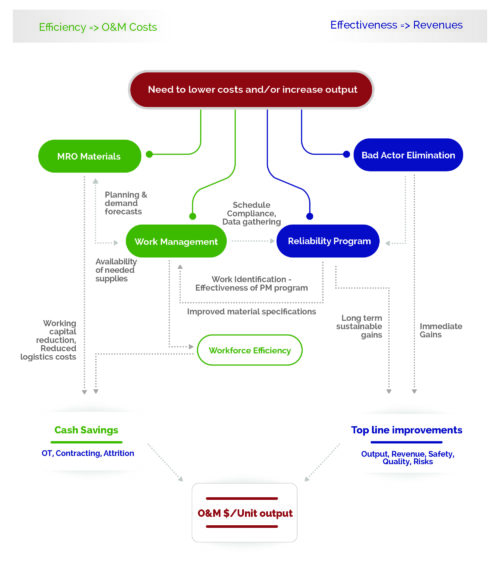As an asset or facility ages beyond its original ROI time horizon, it deteriorates naturally with use and becomes more costly to maintain. The company has recouped its capital investment. Yet as the asset is now producing profitable revenues, it still wants it to perform, if it can be operated and maintained cost effectively. While the time value of money makes those future costs less relevant in the original ROI calculations, it will not make those costs irrelevant when operating the plant 10 years hence. If those costs are high, the asset may be less economical to operate, but if there’s no money to invest in replacement assets, it must continue. A modest upfront investment in reliability, maintainability and operability studies, to determine the best maintenance program and sparing strategies, really pays off as the asset ages.
An older asset that can be run cost effectively, can still compete with a more modern asset. Keeping it in a state to perform that well however, requires a substantial investment in asset management, something that the original ROI projections likely did not consider.
For example:
In Canada we have one of the world’s most cost competitive integrated steel mills; and it is operating in an environment with high labor and energy costs. Parts of that mill are over 60 years old, and most of it is over 40! Replacing that facility today would require upwards about a $10 to 12 billion investment. That mill’s initial capital costs were recouped many, many years ago. Today, keeping it operating and profitable provides a huge value to the company that owns it – in fact, it has been able to perform as a cash cow to help fund improvements at various other mills in the parent company’s global portfolio.
That has been possible because the mill invested in developing its maintenance program to deliver highly reliable operation. It consistently operates at higher-than-average levels of availability for the industry with few disruptions that can result in production delays (losses). That higher availability translates into added production output and revenues.
Taking that sort of potential into account many years into the future, requires more than a simple ROI calculation on a project investment with a 10-year horizon and assuming some “average” level of maintenance spending. In fact, higher investment in that “maintenance definition” up front can result in lower-than-average maintenance costs and better than average production availabilities while conservative ROI calculations likely don’t take those into account. When project financing is being approved the tendency is also to minimize up front costs (don’t invest in any of the “extras” like that maintenance definition) to maximize ROI.
Getting the most from our physical assets requires more than just that initial investment in those assets. Defining the right maintenance program, supporting it so that it can be executed correctly and at the right times, requires a modest additional investment that can pay for itself many times over, and quickly. Not investing in it puts the asset’s anticipated output at risk, and tends to result in excessive maintenance costs just to sustain “average” performance.
Let’s say that you are in the operational phase of your asset’s life cycle. We find that investment in defining that program can still result in substantial cost savings (we’ve seen up to 20%), and revenue gains can easily be measured as multiples of what you’ve just saved. In some cases, we have seen revenues gained exceed the cost savings by an order of magnitude.
Learn more in our book, “Paying Your Way” or talk to us about performing an “Uptime Rapid Value Assessment” of your operational performance.
I am happy to speak with you in an initial 30 minute consultation, with no cost or obligation on your part. Let’s discuss your situation and what can be done. You’ve nothing to lose and you can gain considerable insight by speaking with one of the foremost experts in reliability and maintenance management.


